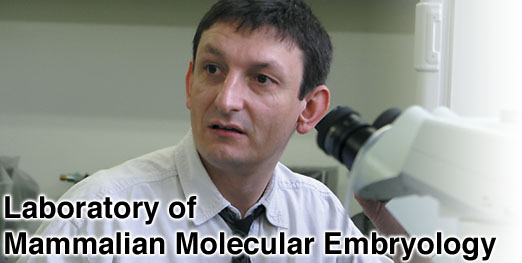




     |

Fertilization achieves the transformation of two specialized cells with little inherent developmental potential - a sperm and an unfertilized egg - by combining them to produce a state of totipotency: a single cell from which all cell types develop to produce an entire individual. The initial period of this remarkable process is known as oocyte activation, an intricate orchestration of sub-cellular events that include all the checks and balances that presage healthy growth of a new embryo. Oocyte activation can be observed under a light microscope as a series of dramatic changes in the morphology of the newly fertilized egg and provides a read-out of the underlying molecular mechanisms. Our laboratory combines molecular and cell biology with piezo-actuated micromanipulation of mouse gametes and embryos to study the events that occur during oocyte activation and their developmental consequences.
We are systematically elucidating interactions between sperm head components and the oocyte at fertilization, particularly during the moments soon after the sperm has penetrated the oocyte. The interests of our lab include attributing molecular identities to the proteins involved in these interactions and characterizing them functionally. This task is daunting, as beneath the membrane of a sperm head reside macromolecular assemblies that include a nucleus (containing the paternal genome and associated proteins) and a surrounding cytoplasmic matrix, the perinuclear matrix (PNM), which rapidly comes into contact with the oocyte cytoplasm at fertilization and is an immediate source of paternally-contributed molecules that may modulate development.
The study of these proteins holds forth the promise of enabling the identification of oocyte signaling pathways and processes that become operational at fertilization and establish what roles they play in subsequent development. Such roles may not be restricted to short-term development, as a growing body of evidence indicates that they have far-reaching consequences, even after the resulting adult reaches advanced age.